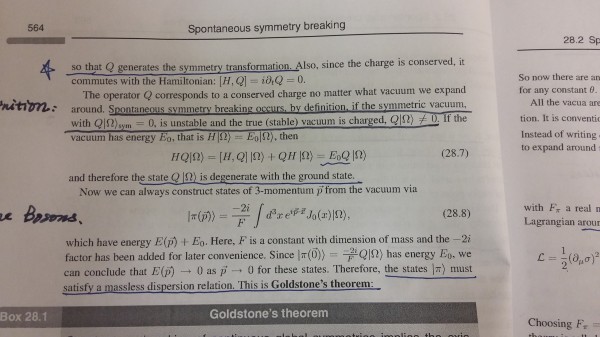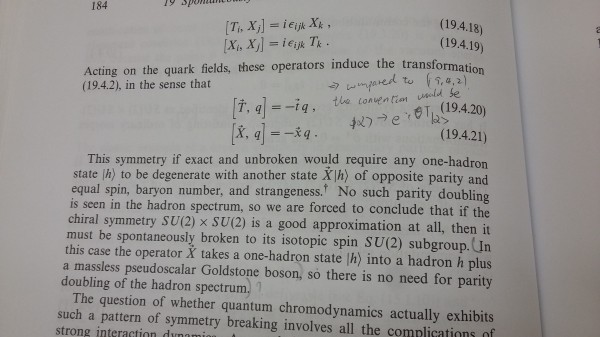It is commonly claimed [2] that, if $j^0$ is a charge (density) that generates a spontaneously broken symmetry transformation, then
$$j^0|\text{VAC}\rangle=|\text{1-Goldstone}\rangle\cdots(1).$$
It can be shown (cf. Weinberg Vol2, chap 19, equation (19.2.34)), that $j^0|\text{VAC}\rangle$ has nonzero overlaps with 1-Goldstone states [1], but how can I see it's not, e.g., a supeposition 1-Goldstone and 2-Goldstone states? Or is equation (1) meant to be taken as a defining formula for 1-Goldstone state? In any case, there seems to be another paradox: it can also be shown (cf. Weinberg Vol2, chap 19, equation (19.2.35)), that $\phi|VAC\rangle$ has nonzero overlaps with 1-Goldstone states, where $\phi$ is the scalar field that acquires VEV in the model[1]. However, by Noether's theorem, $j^0$ is a quadratic function of $\phi$ and $\pi$ ($\pi$ being the canonical conjugate of $\phi$), and if $\phi$ has a mode expansion at all, wouldn't $j^0$ have to contain a term that creates two particles?
Furthermore, in demonstrating the non-existence of parity doubling of hadronic spectrum, it is claimed $$j^0|h\rangle=|h, \text{1-Goldstone}\rangle\cdots(2),$$
where $|h\rangle$ is a 1-hadron state. Even if I take for granted that $j^0$ creats a 1-Goldstone when acting on vacuum, it's still not clear to me why it does not do anything to the hadron at all.
[1] But note in Weinberg's proof, nowhere did he explicitly defined what a 1-Goldstone state is. He only loosely defined 1-particle state as a state of which momentum is the only continuous index, and 1-Goldstone as a massless 1-particle state with nonzero overlap with both $j^\mu|\text{VAC}\rangle$ and $\phi|\text{VAC}\rangle$.
[2] For example, M. Schwartz, Quantum field theory and standard model

Also, Weinberg Vol 2, when talking about nonexistence of hadronic parity doubling:

 Q&A (4831)
Q&A (4831) Reviews (201)
Reviews (201) Meta (437)
Meta (437) Q&A (4831)
Q&A (4831) Reviews (201)
Reviews (201) Meta (437)
Meta (437)